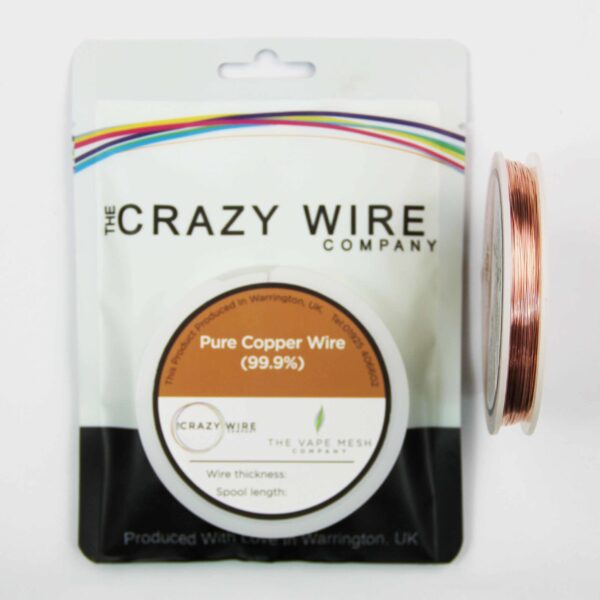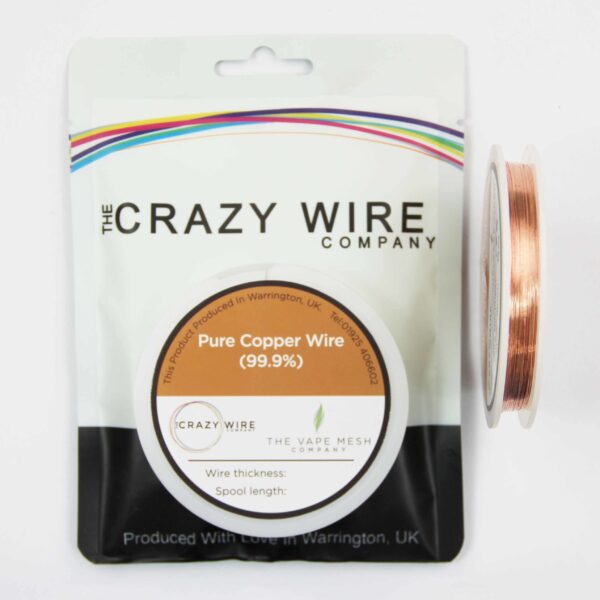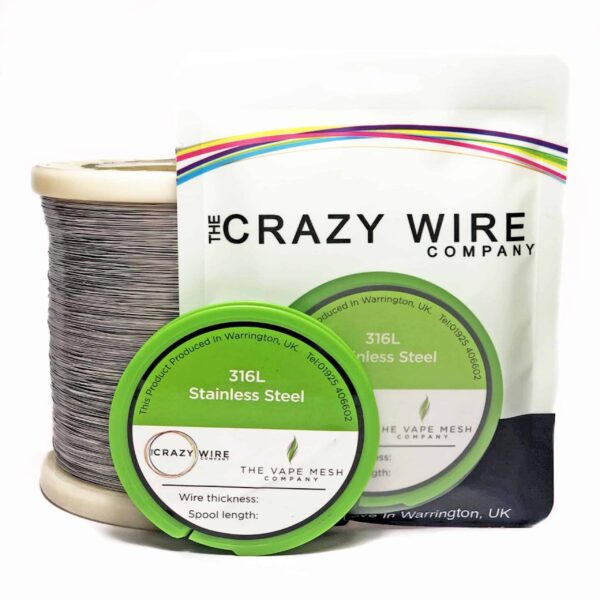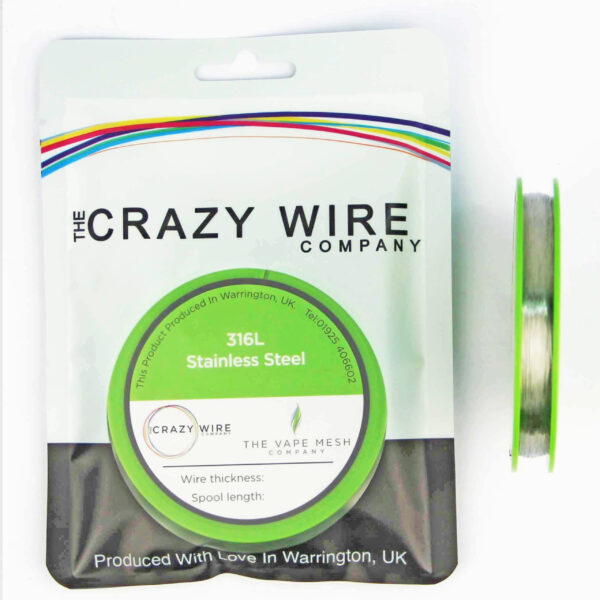Description
0.87mm SS304 Grade Stainless Steel Wire
The Crazy Wire Company are long established as Europe’s preferred suppliers of top quality SS304 grade stainless steel wire. We have enormous stock levels at all times, as we use this wire to weave our marine grade woven mesh products.
SS304 grade stainless steel wire measures 0.87mm in thickness (or 20AWG), making it a highly sought-after material for various applications. Due to its adherence to the acclaimed SS304 grade standards, this wire offers superior resistance to oxidisation and corrosion, particularly in environments with high pH levels, high temperatures, and harsh chemicals. The stainless steel wire is widely recognised for its versatility and is widely used for a variety of applications, including the manufacture of wire mesh and wire cloth. These are commonly used in filtration, sieving, and shielding operations in petrochemical, pharmaceutical, and food processing industries. Its inherent strength and durability make stainless steel 304 grade wire perfect for making wire ropes and strands that offer pivotal support. This is great for architectural structures and secure heavy loads during lifting operations.
In electrical applications, its adept conductivity is good for manufacturing durable and dependable wiring and connectors. Also found in the crafting of springs, stainless steel 304 grade wire provides mechanical durability and anticorrosive properties important to automobiles, industrial machinery, and various durable consumer products. Additionally, it is resistant to tarnishing and delivers an appealing aesthetic that makes it a desirable element in jewelry making. It is often employed to create elegant and durable pieces. Significantly, SS304 grade wire supports itself as a valuable option in broad array of critical applications, aligning its mechanical robustness, resistance, and functional versatility with many demanding conditions.
We provide a comprehensive range of sizes tailored to meet diverse needs. The wire diameters range from a delicate 0.08mm up to a more robust 0.87mm. These sizes correspond to American Wire Gauge (AWG) standards from 40AWG down to 20AWG. To assist with electrical applications, it’s noteworthy that our wire resistances vary from 252.17 Ωm at the finest size, decreasing to 1.2 Ωm as the wire diameter increases.
Specification of this product:
- Diameter -0.87mm (870 Micron – 20 AWG)
- Ohms/ft – 1.2
These specifications not only testify to the wire’s adaptability but also its capacity to fulfill specific requirements in both craftsmanship and technology. When you choose our stainless steel wire, you’re investing in reliability, precision, and quality. Whether you’re working on intricate designs or establishing firm connections, this product ensures you have the best material at your fingertips.
Why Use The Crazy Wire Company
- Quality of products: The Crazy Wire Company always offer high-quality products that meet industry standards and customer expectations.
- Selection: We offer a wide variety of wire products and sizes to meet the diverse needs of our customers. We have more than 600 products available through our site and counting.
- Price: We always offer the best value possible. Our wires are available as part of our major weaving processes, so it is bought at the best possible rate.
- Availability: Our products are kept in house and are ready to ship immediately.
- Customer service: Our experienced staff help our customers feel confident in their purchases and provide assistance when required.
Not only do we offer 304 grade stainless steel wire, but we also stock huge levels of SS316, SS430 (magnetic) and SS317L.
We also offer stainless steel in ribbon and flat wire options.
The choice is virtually endless!
FAQs About This Wire
How Resilient Is SS304 Grade Wire To Mechanical Stress And Pressure?
The robustness of SS304 grade wire under mechanical stress and pressure has solidified its status as a preferred material for mechanically intensive applications. Under significant stresses and loads, SS304 stainless steel maintains its structural integrity despite its commendable resistance to mechanical deformation. This resilience is largely attributed to its inherent mechanical properties and austenitic microstructure. This not only provides substantial tensile strength but also exhibits appreciable elongation capabilities, enabling it to absorb and distribute applied stresses effectively while still retaining its ductility.
Additionally, SS304 grade wire is hard enough to resist wear, abrasion, and material fatigue. This makes it ideal for springs, wire ropes, and structural components that require persistent mechanical performance. The quality of SS304 wire, coupled with its well-established corrosion resistance, positions it as a foremost choice for applications requiring mechanical and chemical resilience, especially under fluctuating environmental conditions. Construction, automotive, and manufacturing industries use SS304 grade wire to navigate and navigate mechanical stress and pressure effectively and reliably.
What Alternative Materials Compare To SS304 Grade Wire In Terms Of Functionality?
In the context of functionality and utility across diverse applications, several alternative materials may present themselves as counterparts to SS304 grade wire. Each have their intrinsic properties and application-specific advantages. SS316 grade stainless steel wire is often brought into comparison due to its enhanced corrosion resistance, particularly in chloride-exposed environments. This is to make it apt for marine and chemical processing applications. On another note, SS316L, a low carbon variant of SS316, offers similar corrosion resistance with improved weldability. In environments where higher tensile strength and mechanical properties are pivotal, SS316 might supersede SS304. Additionally, SS430 grade stainless steel, albeit with lower corrosion resistance, offers a magnetisable alternative. It can be used in applications where magnetic properties are crucial. Moreover, carbon steel wire, while not matching the corrosion resistance of SS304, can provide significant mechanical strength and is often economically more viable for certain applications.
Alternatively, for enhanced electrical conductivity and malleability, copper wire often emerges as a notable option, albeit sacrificing the stainless and robust strength characteristics of SS304. In some niche applications, alloy wires like Inconel, which offer exceptional high-temperature and corrosion resistance, might be considered. It’s imperative to note that the selection among these materials ultimately hinges on a thorough evaluation of specific application needs, balancing factors such as mechanical strength, corrosion resistance, environmental considerations, and budgetary constraints, to discern the most apt material choice parallel to SS304 grade wire.
What Is The Process For Repairing Or Joining Broken SS304 Grade Wire?
Repairing or joining broken SS304 grade wire, especially in applications where integrity and strength are paramount, typically involves a methodical approach using welding or soldering, depending on the specific use case and dimensional attributes of the wire.
Welding Method:
- Preparation: Begin by cleaning the broken ends of the SS304 wire, ensuring that there are no contaminants or oxides that might compromise the weld quality.
- Alignment: Align the broken wire ends together ensuring they are straight and in close proximity to ensure a solid and straight weld.
- Welding: Utilizing a TIG (Tungsten Inert Gas) welding process is a common method for stainless steel due to its precision and control. Employ a filler material that matches the SS304 grade to maintain the integrity and properties of the wire.
- Post-Weld Treatment: Depending on the application, post-weld treatments like annealing may be required to relieve stress and optimise corrosion resistance. A thorough inspection and potential polishing may also be performed to ensure a smooth surface and structural reliability.
Soldering Method:
- Preparation: Start by thoroughly cleaning the SS304 wire segments to be joined, removing any debris, or oxides.
- Flux Application: Apply a flux to the wire ends to facilitate the flow of the solder material and prevent oxidation during the soldering process.
- Soldering: Using a soldering iron and a suitable solder alloy (often silver solder for SS304 due to its strong bonding and corrosion-resistant characteristics), join the broken wire ends by melting the solder between them.
- Cleaning: After the solder has solidified, clean the joined area to remove any residual flux. Then inspect the joint for consistency and strength.
In both methods, utmost attention to safety, wire alignment, and adherence to optimal temperature profiles is pivotal. This is to ensure a reliable and durable repair or joining of the SS304 grade wire. Furthermore, post-repair testing and inspection should be conducted to validate the integrity of the repair job. This will also ensure that the wire maintains its desired properties and performance in its specific application. Always adhere to relevant guidelines and standards to ensure both safety and functionality in the repaired wire.
The Crazy Wire Company is a leading UK based supplier of nichrome, FeCrAl, and stainless steel wires. We specialise in rapid delivery to any location around the country. Our factory is located in Warrington, which is the historic home of the UK’s wire industry.
Check out our blog ‘What You Need To Know About: Stainless Steel Wires’ for more information on resistance wire in general. Our goal for our blogs and help guides is to answer as many questions as possible to help to explain the possibilities of mesh to our customers.
We also offer similar products through our highly popular eBay store, check us out there too.
Contact our team today if you have any questions at all. We are always really keen to help in any way that we can.












